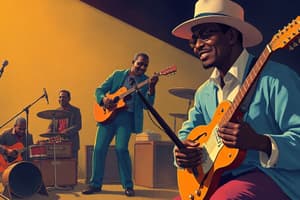Podcast
Questions and Answers
What is often credited with bringing blues music to mainstream audiences in the 1920s?
What is often credited with bringing blues music to mainstream audiences in the 1920s?
- Son House's Delta Blues style
- W.C. Handy's first blues sheet music
- Mamie Smith's 'Crazy Blues' (correct)
- Muddy Waters' electric guitar performances
Which regional style of blues is characterized by slide guitar and raw emotional expression?
Which regional style of blues is characterized by slide guitar and raw emotional expression?
- Delta Blues (correct)
- Chicago Blues
- Piedmont Blues
- Texas Blues
Who is often referred to as the 'Father of the Blues' for his role in popularizing the genre?
Who is often referred to as the 'Father of the Blues' for his role in popularizing the genre?
- Robert Johnson
- Blind Willie McTell
- W.C. Handy (correct)
- Muddy Waters
Which of the following plays a significant role in the cultural expression of African American experiences during the civil rights movement?
Which of the following plays a significant role in the cultural expression of African American experiences during the civil rights movement?
What was a significant characteristic of Chicago Blues compared to other regional styles?
What was a significant characteristic of Chicago Blues compared to other regional styles?
In what decade did blues experience a significant increase in recordings and commercial popularity?
In what decade did blues experience a significant increase in recordings and commercial popularity?
Which artist is associated with the Piedmont Blues style?
Which artist is associated with the Piedmont Blues style?
Which of the following genres is NOT influenced by blues music?
Which of the following genres is NOT influenced by blues music?
Flashcards are hidden until you start studying
Study Notes
History Of Blues
-
Origins:
- Emerged in the late 19th century, primarily among African American communities in the Deep South.
- Influenced by African musical traditions, spirituals, work songs, and folk music.
-
Early Development:
- First documented in the 1910s with the publication of the first blues sheet music.
- Notable figures include W.C. Handy, often referred to as the "Father of the Blues," who helped popularize the genre.
-
1920s - The Blues Boom:
- The 1920s saw a significant increase in recordings and the rise of blues as a commercial genre.
- Mamie Smith's "Crazy Blues" (1920) is often credited with bringing blues to mainstream audiences.
-
Regional Styles:
- Delta Blues: Characterized by slide guitar and raw emotional expression; prominent musicians include Robert Johnson and Son House.
- Chicago Blues: Evolved in the urban environment, featuring electric instruments; notable artists include Muddy Waters and Howlin' Wolf.
- Piedmont Blues: A lighter, fingerpicking style prevalent in the Southeastern U.S.; associated with artists like Blind Willie McTell.
-
Influence on Other Genres:
- Blues laid the foundation for rock and roll, jazz, and R&B.
- Many rock musicians, like Eric Clapton and The Rolling Stones, have cited blues as a major influence.
-
Civil Rights Era:
- Blues music played a significant role in the cultural expression of the African American experience during the civil rights movement.
- Songs often reflected themes of struggle, resilience, and hope.
-
Modern Blues:
- Today, blues continues to evolve, incorporating elements from rock, jazz, and contemporary music.
- Festivals and award shows celebrate the genre globally, maintaining its relevance in modern music culture.
Origins
- Emerged in the late 19th century among African American communities in the Deep South.
- Influenced by a blend of African musical traditions, spirituals, work songs, and folk music.
Early Development
- Documented first in the 1910s with initial publication of blues sheet music.
- W.C. Handy, known as the "Father of the Blues," played a crucial role in popularizing the genre.
1920s - The Blues Boom
- Marked by a significant rise in recordings, bringing blues into the commercial sphere.
- Mamie Smith's "Crazy Blues" (1920) was pivotal in introducing blues to mainstream audiences.
Regional Styles
- Delta Blues: Known for slide guitar and emotional expression, with key figures like Robert Johnson and Son House.
- Chicago Blues: Developed in urban areas using electric instruments, featuring artists such as Muddy Waters and Howlin' Wolf.
- Piedmont Blues: A fingerpicking style prevalent in the Southeastern U.S., associated with artists like Blind Willie McTell.
Influence on Other Genres
- Served as the foundation for rock and roll, jazz, and R&B.
- Influential for numerous rock musicians, including Eric Clapton and The Rolling Stones.
Civil Rights Era
- Integral to cultural expression during the civil rights movement reflecting themes of struggle, resilience, and hope.
Modern Blues
- Continues to evolve, merging elements from rock, jazz, and contemporary music.
- Global festivals and award shows emphasize the genre's ongoing relevance in today's music culture.
Studying That Suits You
Use AI to generate personalized quizzes and flashcards to suit your learning preferences.



